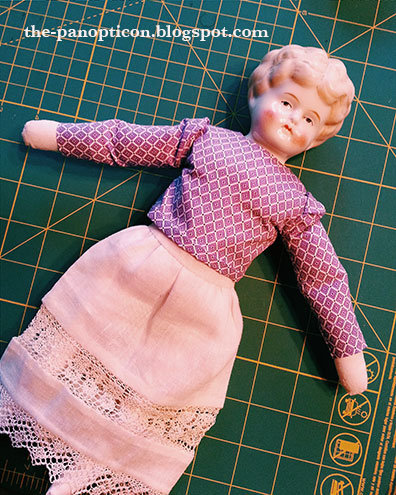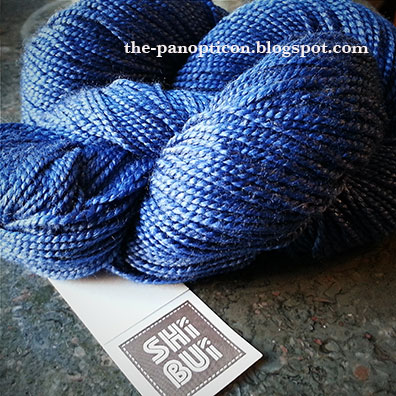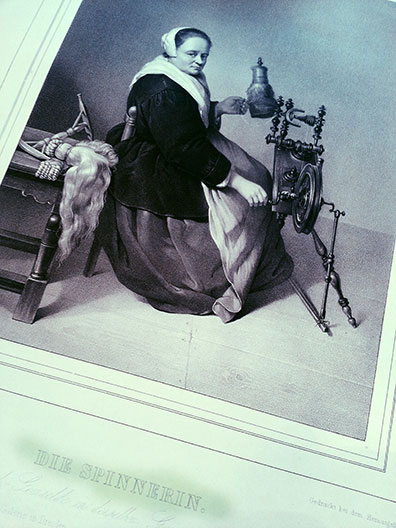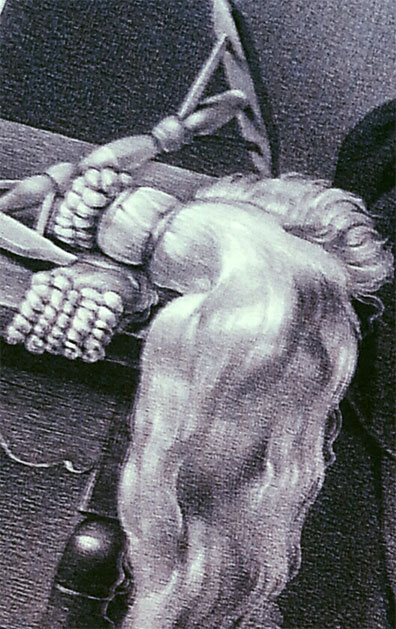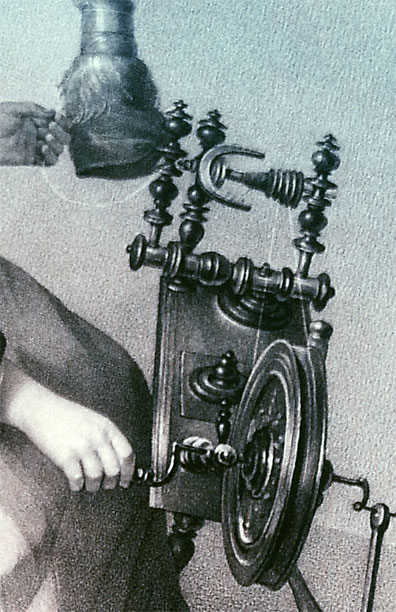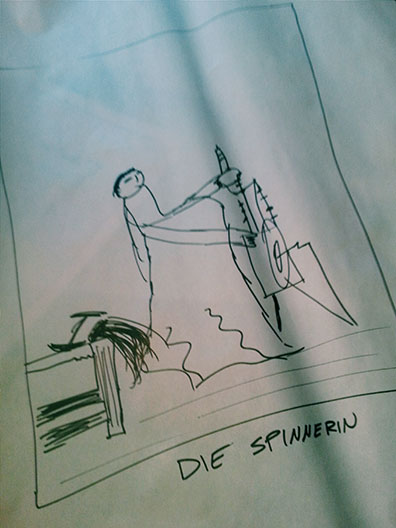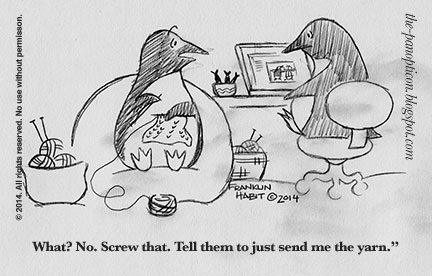Thursday, December 25, 2014
Thursday, December 11, 2014
Me, Elsewhere: Lion Brand Blog and Knitty, Winter 2014
I don't know if I've mentioned here before that I produce a monthly illustrated essay for none other than Lion Brand Yarns. Have I mentioned that? Well, now I've mentioned that.
The December edition is newly up, and the topic is what to do when you're a knitter who doesn't feel like knitting. It's also about what to do when you're a weaver who doesn't want to weave, a crocheter who can't be bothered to pick up a hook, a tatter who is shuttle-weary, etc.
And right on schedule, it's the Winter 2014 Knitty. My "Stitches in Time" column for this edition offers for your consideration an 1880s pattern for a pair of gloves, along with thoughts on why knitting gloves is not difficult, and why you should. Also: thoughts on mid-Victorian knitted faux-ermine muffs, and why I won't.


Ethel News
Sewing on Ethel's dress continues apace. The bodice is now complete except for the high collar, the hook-and-eye closures at the back, and of course the lace trim.
I haven't settled on tatting or knitting yet for the lace. There was a comment (I believe in jest) in the comments for the last entry that I do it in crochet...unless I subscribe to the notion that crochet is inherently ignoble.
For those of you who appear not to have caught the tone of that commenter's comment, I want to be perfectly clear that I do not hold any such ideas about crochet. In fact I am publicly on record in many places (including one of my own columns) as saying that I find the modern custom of keeping knitting and crochet in separate, armed camps is stupid. Neither do I believe one is superior to the other.
The lace won't be crocheted because at present I haven't got the chops to do it well at the required gauge. I'm learning, but I'm not up to crochet with thread just yet. The kind offers to do it for me are much appreciated; but to paraphrase Hotspur in Shakespeare's Henry IV, Part I, she's my dolly and I'm a grown man and I have to do the work.
Travel Knitting
I'm about to go on the trip that is, remarkably, not for work. I won't have Internet access for any of it, so this is the last entry until just before Christmas. The important packing is complete, which is to say I know which needlework is coming along. I'm particularly excited about what's going to happen to this...
It's Shibui Staccato (merino and silk fingering weight) in Blueprint and I would sit here and stare at it all afternoon if Ethel were not reminding me that she expects a skirt sooner rather than later.
See you in a few weeks, kids. Be good.
Thursday, December 04, 2014
Pins and Needles, Needles and Pins
Remember Ethel?
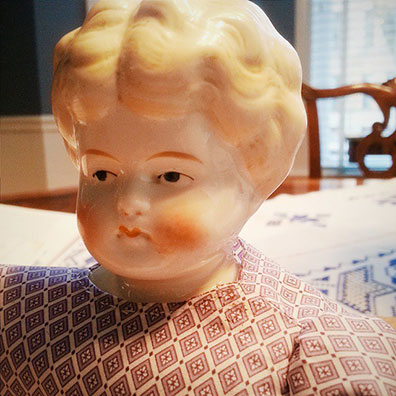
You may or may not, it's been a while since I wrote about her.
She came into my life via a tray of miscellaneous junk at a flea market, lacking everything from the waist down. But I took care of that.
So she was entire, but naked. I decided to dress her, starting with a linen-and-lace petticoat.
Then things got busy, and Ethel has been sitting around in just her underwear since then. She hasn't complained as such, but the look on her face speaks volumes.

Happily, my friend and collaborator John Mullarkey threw me a sewing challenge. He has a long-delayed shirt that needs to be finished. I have a doll who is threatening to telephone the ASPCD and turn me in for neglect. Let's cheer each other along, he said. Fine, I said. So out came the needles and thread.
We began well.
I want to sew something reasonably appropriate–with two disclaimers.
First, I'm not producing miniature clothing (i.e. correct in all aspects, perfectly to scale). I'm making a dress for a doll, rather as Ethel's original owner might have. (Serious Doll People will recoil. With no disrespect to them, I am not a Serious Doll Person.)
Second, for this project I'm not fussing and fretting over perfect period (c. 1900) detail. Ethel probably "should" be in a shirtwaist with pin tucks and certain other details,
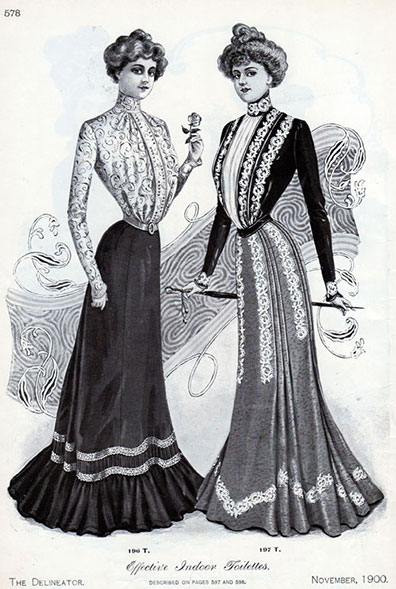
but I know myself well enough to understand that if I begin this project with research, I'll never cut anything out. I will bog down, debate, and prevaricate. This is supposed to be a sewing exercise, not a trip to the library.
And I don't especially feel like sewing a shirtwaist. This dress is largely an excuse to make more thread lace (probably tatted and knitted) and stick it on something.
Anyhow, I drafted the bodice and sleeves (yes, I use paper towels) and felt pretty good about the results. Flat pattern making is new ground for me.
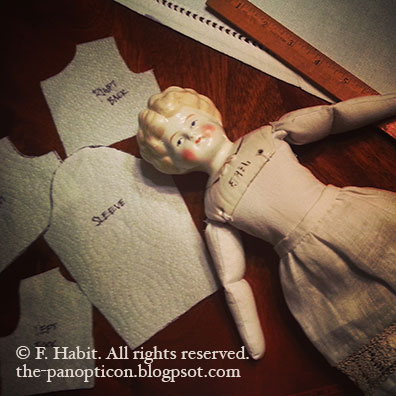
Then, after a deep breath, sewing.
I enjoy hand sewing, but most of my training was under the stern eye of my late grandmother. She was a tailor. When I helped her I was usually working on tailored clothing, so there are certain weird gaps in my education–like gathering. Not a lot of gathers in man's suit. Ethel's full sleeve caps require gathering.
I swore a lot, but I finished the sleeve cap and it didn't look half bad. After a day off, I sat down with second sleeve. Marked, gathered, pinned. Sewed.
It was so much easier the second time! About forty minutes from start to finish, and so uneventful that I actually thought as I made the last few stitches, "Well, so much for having an amusing tale to post on the blog." Because you know, projects that go well are never funny.
I clipped the final thread, turned the piece right-side out, and realized I had sewn the second sleeve into the same armscye as the first sleeve.
You really can't fudge that with ironing.
Rip, rip, rip.
We are in a better place now, but Ethel is still giving me That Look.
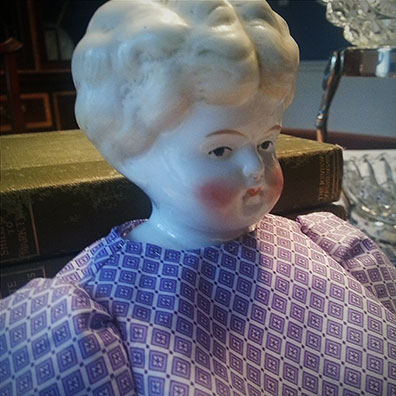
She sure throws a lot of attitude for somebody who was fished out of a junk tray at a flea market.

You may or may not, it's been a while since I wrote about her.
She came into my life via a tray of miscellaneous junk at a flea market, lacking everything from the waist down. But I took care of that.
So she was entire, but naked. I decided to dress her, starting with a linen-and-lace petticoat.
Then things got busy, and Ethel has been sitting around in just her underwear since then. She hasn't complained as such, but the look on her face speaks volumes.

Happily, my friend and collaborator John Mullarkey threw me a sewing challenge. He has a long-delayed shirt that needs to be finished. I have a doll who is threatening to telephone the ASPCD and turn me in for neglect. Let's cheer each other along, he said. Fine, I said. So out came the needles and thread.
We began well.
I want to sew something reasonably appropriate–with two disclaimers.
First, I'm not producing miniature clothing (i.e. correct in all aspects, perfectly to scale). I'm making a dress for a doll, rather as Ethel's original owner might have. (Serious Doll People will recoil. With no disrespect to them, I am not a Serious Doll Person.)
Second, for this project I'm not fussing and fretting over perfect period (c. 1900) detail. Ethel probably "should" be in a shirtwaist with pin tucks and certain other details,

but I know myself well enough to understand that if I begin this project with research, I'll never cut anything out. I will bog down, debate, and prevaricate. This is supposed to be a sewing exercise, not a trip to the library.
And I don't especially feel like sewing a shirtwaist. This dress is largely an excuse to make more thread lace (probably tatted and knitted) and stick it on something.
Anyhow, I drafted the bodice and sleeves (yes, I use paper towels) and felt pretty good about the results. Flat pattern making is new ground for me.

Then, after a deep breath, sewing.
I enjoy hand sewing, but most of my training was under the stern eye of my late grandmother. She was a tailor. When I helped her I was usually working on tailored clothing, so there are certain weird gaps in my education–like gathering. Not a lot of gathers in man's suit. Ethel's full sleeve caps require gathering.
I swore a lot, but I finished the sleeve cap and it didn't look half bad. After a day off, I sat down with second sleeve. Marked, gathered, pinned. Sewed.
It was so much easier the second time! About forty minutes from start to finish, and so uneventful that I actually thought as I made the last few stitches, "Well, so much for having an amusing tale to post on the blog." Because you know, projects that go well are never funny.
I clipped the final thread, turned the piece right-side out, and realized I had sewn the second sleeve into the same armscye as the first sleeve.
I sewed two sleeves into the same armscye.
And didn't realize it until I was finished.
You really can't fudge that with ironing.
Rip, rip, rip.
We are in a better place now, but Ethel is still giving me That Look.

She sure throws a lot of attitude for somebody who was fished out of a junk tray at a flea market.
Monday, November 24, 2014
Me, Elsewhere: Twist Collective
The newest issue of Twist Collective was published yesterday. My contribution is a paean to Elizabeth Zimmermann's knitting videos, plus a drinking game.
In our time, what greater tribute can a devoted fan offer to a beloved series than a drinking game?
Slash fiction, I suppose. But I'm not going to do that so don't even ask.
Slash fiction, I suppose. But I'm not going to do that so don't even ask.
(If you don't imbibe, don't worry. Neither do I. It works equally well with cocoa or tea. Or, come to that, it works with little bits of chocolate, or shortbread, or... .)
Read it here.
Friday, November 21, 2014
Magic
I've been taking a multi-week course in bookbinding.
This will surprise absolutely nobody who knows me well and has therefore heard me pine wistfully for a press and a bindery to call my own.
I'm enjoying it. The teacher is excellent, the fee is reasonable, and my first efforts are imperfect but promising. Last time we did Japanese stab bindings:
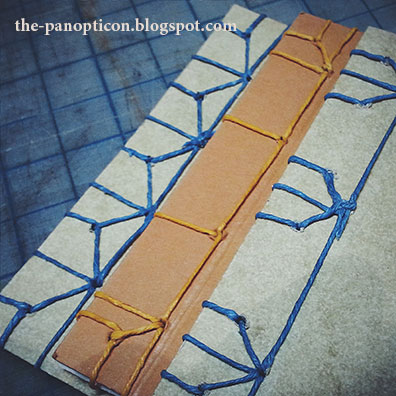
The studio itself has taken getting used to.
I'm usually surrounded by fiber arts folks. Here's the thing about fiber arts folks: they're humble. Doesn't matter who they are or what they've done, you'll have to look hard to find a knitter who will throw attitude at you because she's got four decades of professional experience and has written a string of classic books.
This is probably due at least in part to the greater world's general sniffing disdain for textile arts, especially knitting and crochet. These are (so they say) unserious, unimportant, practiced by the sad and the shut-in. They're wrong and stupid about that; but on the positive side it does tend to keep us grounded.
Snobs there are, yes, and those whose folies de grandeur make for fun industry gossip. But they're a distinct minority.
So it was a bit of a cold bath to be reminded when I walked into the print studio for the first time what a room full of extreme self-importance feels like. Absolutely everyone in sight (except me) was a Serious Artist to Be Taken Seriously.
I heard more theorizing, posturing, and pronouncing in five minutes than in all the previous year. I heard an early-twentysomething who was silkscreening a cartoon owl onto a t-shirt refer un-ironically to "my earlier body of work."
I don't do very well in situations like this. I get scared and I shrink. I mumble. I took my bone folder and awl and sat in a corner and tried to disappear.
Last week I went into the room where the paper guillotine* lives, and just as I was getting ready to chop the head of my little perfect-bound book, one of the Serious Artists looked up from her bench–she was scrutinizing a very gorgeous letterpress poster–and asked me about my scarf. This scarf, which was made of leftovers from Longer on the Inside:
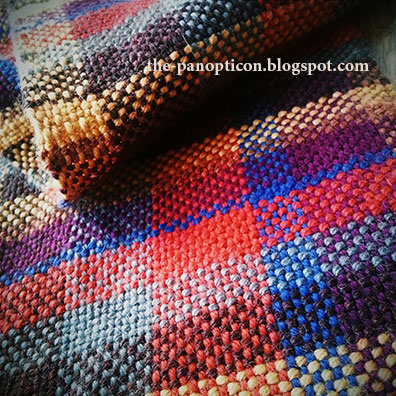
"I love those colors," she said. "Where did you get it?"
"I made it," I said.
She was taken aback.
"You mean you...what? You sewed it or something?"
"No, I made it. I wove it."
"You wove it? You mean you made the actual fabric?"
"Yes. On a loom."
"You made fabric?"
"Yes."
"Oh my god," she said. "That's incredible. You actually made fabric? From scratch? Can I touch it? Would it be okay if I touched it?"
I let her touch it.
"I just can't believe you made fabric," she said. "That's like...magic."
Good to hear. Good to be reminded that what we do can startle even Very Serious Artists.
We're magic.
*Ohhhhh, the paper guillotine. It's so beautiful. Cast iron, almost five feet high, easily a century old. Can slice tiny slivers off the edge of stack of telephone books. Enormous, graceful curving lever to lower the blade. The paper guillotine. Mmmmmmm.
This will surprise absolutely nobody who knows me well and has therefore heard me pine wistfully for a press and a bindery to call my own.
I'm enjoying it. The teacher is excellent, the fee is reasonable, and my first efforts are imperfect but promising. Last time we did Japanese stab bindings:

The studio itself has taken getting used to.
I'm usually surrounded by fiber arts folks. Here's the thing about fiber arts folks: they're humble. Doesn't matter who they are or what they've done, you'll have to look hard to find a knitter who will throw attitude at you because she's got four decades of professional experience and has written a string of classic books.
This is probably due at least in part to the greater world's general sniffing disdain for textile arts, especially knitting and crochet. These are (so they say) unserious, unimportant, practiced by the sad and the shut-in. They're wrong and stupid about that; but on the positive side it does tend to keep us grounded.
Snobs there are, yes, and those whose folies de grandeur make for fun industry gossip. But they're a distinct minority.
So it was a bit of a cold bath to be reminded when I walked into the print studio for the first time what a room full of extreme self-importance feels like. Absolutely everyone in sight (except me) was a Serious Artist to Be Taken Seriously.
I heard more theorizing, posturing, and pronouncing in five minutes than in all the previous year. I heard an early-twentysomething who was silkscreening a cartoon owl onto a t-shirt refer un-ironically to "my earlier body of work."
I don't do very well in situations like this. I get scared and I shrink. I mumble. I took my bone folder and awl and sat in a corner and tried to disappear.
Last week I went into the room where the paper guillotine* lives, and just as I was getting ready to chop the head of my little perfect-bound book, one of the Serious Artists looked up from her bench–she was scrutinizing a very gorgeous letterpress poster–and asked me about my scarf. This scarf, which was made of leftovers from Longer on the Inside:

"I love those colors," she said. "Where did you get it?"
"I made it," I said.
She was taken aback.
"You mean you...what? You sewed it or something?"
"No, I made it. I wove it."
"You wove it? You mean you made the actual fabric?"
"Yes. On a loom."
"You made fabric?"
"Yes."
"Oh my god," she said. "That's incredible. You actually made fabric? From scratch? Can I touch it? Would it be okay if I touched it?"
I let her touch it.
"I just can't believe you made fabric," she said. "That's like...magic."
Good to hear. Good to be reminded that what we do can startle even Very Serious Artists.
We're magic.
*Ohhhhh, the paper guillotine. It's so beautiful. Cast iron, almost five feet high, easily a century old. Can slice tiny slivers off the edge of stack of telephone books. Enormous, graceful curving lever to lower the blade. The paper guillotine. Mmmmmmm.
Saturday, November 15, 2014
All About That Lace
I am nothing if not easily distracted. What's below is the kind of thing that creeps into my notebooks when I am supposed to be doing serious work.
If Meghan Trainor's bouncy ode to the curvaceous posterior, "All About That Bass",
can spawn a Star Wars version, a high school literacy version, and a forties jazz version, et al., I see no reason why we knitters should not have a version of our own.
can spawn a Star Wars version, a high school literacy version, and a forties jazz version, et al., I see no reason why we knitters should not have a version of our own.
I sing like a screech owl and haven't got the time to make a video (perhaps the Mason-Dixon ladies will oblige?), but here's my contribution to the boom boom on the dance floor.
Because you know
I’m all about that lace, 'bout that lace,
No cables.
I’m all about that lace, 'bout that lace,
No cables.
I’m all about that lace, 'bout that lace,
No cables.
I’m all about that lace,
'Bout that lace, lace, lace.
Yeah, it’s pretty clear
I need a size 2.
'Cause I been swatching, swatching,
Like I’m supposed to do.
'Cause I know what you need to make it all lace–
All the right holes in all the right places.
The knitting magazines down at the local shop,
You want a pretty shawl? They got a bumper crop.
Yarn over, knit together, and never stop
'Til every inch of it
is perfect
From the bottom to the top.
You know my mama she told me don’t worry about the size,
She said a shawl can be tiny or cover you to the thighs.
You know I won’t knit your sweater for Christmas like
Santa’s elf.
So if that’s what you want you can knit it your own damn
self.
Because you know
I’m all about that lace, 'bout that lace,
No cables.
I’m all about that lace, 'bout that lace,
No cables.
I’m all about that lace, 'bout that lace,
No cables.
Hey!
I’m using silk and yak,
I like the way my little needles clack,
I maybe wish I hadn’t chosen black–
But I won’t give up
'Til every inch of it is perfect
From the bottom to the top.
You know my mama she told me don’t worry about the size,
She said a shawl can be tiny or cover you to the thighs.
You know I won’t knit your sweater for Christmas like
Santa’s elf.
So if that’s what you want you can knit it your own damn
self.
Because you know
I’m all about that lace, 'bout that lace,
No cables.
I’m all about that lace, 'bout that lace,
No cables.
I’m all about that lace, 'bout that lace,
No cables.
I’m all about that lace, 'bout that lace,
No cables.
I’m all about that lace,
'Bout that lace.
Hey, hey, ohh.
You know you like this lace.
Sunday, November 02, 2014
Strongly Disagree
I taught at Vogue Knitting LIVE! Chicago once again this year, and it's always kind of a kick to do a gig in my own town. No jet lag, no airport security lines, and I already know where to get lunch.
I also get to say hello to a fair number of friends who live in various places around the Midwest and travel in for the big shows or events. One of them–I'll call her Martha–decided to sign up for my class on the gorgeous traveling stitch patterns (the stitches travel, not the patterns) commonly known to English-speaking knitters as Bavarian Twisted Stitch. You may also know it as Austrian Twisted Stitch, or (if you speak German) you may know it as one of the many forms of Strickmüster, or knitting patterns.
You may not know it at all, in which case please allow me to recommend my class. (My calendar is always here–did you know I'm sailing to Alaska in July?)
Anyhow, Martha showed up a bit early to chitchat and catch up. We went to Meg Swansen's Knitting Camp together a couple times, but don't get to see each other much. She asked how the show was going. Dandy, I said. Good students, happy classes.
"I'm sure your classes are always happy," she said.
Well, I try. I try my damnedest. My classes take about a year of preparation to début; and ever after they are subject to constant fine-tuning. It's not enough to know how to do something in order to teach it. You have to–this is my opinion, anyhow–know it well enough to explain it at least five different ways. Not everyone learns in the same way, or at the same pace. You must be able to adjust your teaching to suit the students who walk through the door, and anybody can walk through the door.
Even so, you can't please everyone. Sometimes your feedback forms come back with disgruntled comments. I've had marks taken off for
I wish to share with you select excerpts from Martha's comments on my teaching.
Would you take another class with this teacher?
I don't know. Will there be wine?
Would you suggest this class to a friend?
Only if they want to learn something.
Additional comments and/or suggestions.
Although instructor wore hat, nevertheless appeared to be unable to bilocate. Only in one part of room at any given time.
Was unaware that knitting is prerequisite for this class.
Purl stitches do not travel? This seems discriminatory.
Cannot decide whether these German-style charts prevent Alzheimer's or promote it.
Instructor's bow tie did not light up.
EDITED TO ADD: I must not be coming across quite clearly to all. Martha is (as I wrote) a good friend. Her lampooned feedback form, as quoted above, made me laugh. The other comments, from other classes at other events, aren't posted as a cry of pain–I thought they were funny. What can person do in the face of such absurdity but roll his eyes? Outrage would be an overreaction.
I also get to say hello to a fair number of friends who live in various places around the Midwest and travel in for the big shows or events. One of them–I'll call her Martha–decided to sign up for my class on the gorgeous traveling stitch patterns (the stitches travel, not the patterns) commonly known to English-speaking knitters as Bavarian Twisted Stitch. You may also know it as Austrian Twisted Stitch, or (if you speak German) you may know it as one of the many forms of Strickmüster, or knitting patterns.
You may not know it at all, in which case please allow me to recommend my class. (My calendar is always here–did you know I'm sailing to Alaska in July?)
Anyhow, Martha showed up a bit early to chitchat and catch up. We went to Meg Swansen's Knitting Camp together a couple times, but don't get to see each other much. She asked how the show was going. Dandy, I said. Good students, happy classes.
"I'm sure your classes are always happy," she said.
Well, I try. I try my damnedest. My classes take about a year of preparation to début; and ever after they are subject to constant fine-tuning. It's not enough to know how to do something in order to teach it. You have to–this is my opinion, anyhow–know it well enough to explain it at least five different ways. Not everyone learns in the same way, or at the same pace. You must be able to adjust your teaching to suit the students who walk through the door, and anybody can walk through the door.
Even so, you can't please everyone. Sometimes your feedback forms come back with disgruntled comments. I've had marks taken off for
- the font I used in a handout ("Sans serif faces are unprofessional"),
- wearing a bow tie ("so pretentious"),
- not keeping the room warm enough (we were in a barn at a fiber festival),
- talking too much (I was, you know–teaching),
- being too gay,
- being too unattractive, and
- not making it clear in advance that a class on lace charting would require the students to use lace charts.
I wish to share with you select excerpts from Martha's comments on my teaching.
Would you take another class with this teacher?
I don't know. Will there be wine?
Would you suggest this class to a friend?
Only if they want to learn something.
Additional comments and/or suggestions.
Although instructor wore hat, nevertheless appeared to be unable to bilocate. Only in one part of room at any given time.
Was unaware that knitting is prerequisite for this class.
Purl stitches do not travel? This seems discriminatory.
Cannot decide whether these German-style charts prevent Alzheimer's or promote it.
Instructor's bow tie did not light up.
EDITED TO ADD: I must not be coming across quite clearly to all. Martha is (as I wrote) a good friend. Her lampooned feedback form, as quoted above, made me laugh. The other comments, from other classes at other events, aren't posted as a cry of pain–I thought they were funny. What can person do in the face of such absurdity but roll his eyes? Outrage would be an overreaction.
Thursday, September 25, 2014
That's What Friends Are For
I was in Seattle, enjoying a weekend of lectures and classes at Makers' Mercantile, when a long-time reader came forward with a magnificent gift.
She remembered that I am (in a very small way) a print collector, and gave me this.
It's called Die Spinnerin, engraved in the nineteenth century after a painting by the 17th-century Dutch artist Caspar Netscher. It made my dark little heart go thumpitta-thumpitta-thumpitta-boom.
The folio sheet (21 by 28) hasn't been cut. The tones and textures, which defy capture by my cut-rate phone camera, are pure velvet.
Then there's the subject matter, of course, with all the lovingly rendered details: the niddy-noddy, the hank of flax,
the little hand-cranked* (!) wheel. (Single drive? Curious. I would love to hear from anyone who might know whether this is accurate, or whether the artist goofed. All the rest is captured in such fine detail that it seems odd he would leave out an entire loop of the drive band, if it were actually there.)
This isn't the sort of thing you fold up and stuff in a suitcase, so I asked my good buddy Chuck at Skacel if he could please hand it over to their shipping department and have it sent home to me.
I got a message from Chuck a few days later saying that (as you might imagine would happen at a yarn company) the print had caused quite a stir and everybody had wanted to run away with it.
In due course, a sturdy tube arrived from Skacel. Inside was the sweet spinning lady, looking as beautiful as ever.
Thanks, Chuck! You're the best!
*Edited to add: Mind you, there is a footman, which suggests there is also a treadle hidden under the skirts. So, hand-cranked and foot-powered? The more I look at this the more fascinated I get.
*Edited to add: Mind you, there is a footman, which suggests there is also a treadle hidden under the skirts. So, hand-cranked and foot-powered? The more I look at this the more fascinated I get.
Sunday, June 01, 2014
Miniature Entry: Cheat Sheet from the Past
A dear friend recently gave me a magnificent present that deserves (and will get) its own entry. But tucked inside this gift was a piece of paper, the survival of which amazes me.
It's a sheet of the slick, translucent typing paper that some of us remember was called onionskin.
Yellowed, battered, and containing...
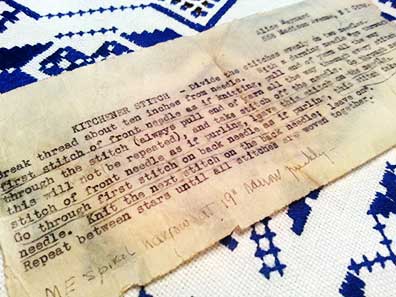
typed instructions for Kitchener stitch.
Below the typed copy is a spidery line of manuscript that reads...
ME spiral narrow at 19" narrow quickly
Somebody was making socks, I bet. Knee socks, maybe? If you were to knit a 19-inch tube, quick spiral decreases would give you a toe at the right point for a short woman's knee sock.
Or, possibly, "spiral" applies to "ME" and the socks were akin to the spiral stockings (knit without heel shaping) in Mary Thomas's Knitting Book.
I can't say with any certainty what "ME" means. Make Even? Possibly, though it's not a usage I have run across before.
In the upper right corner is a name and address:
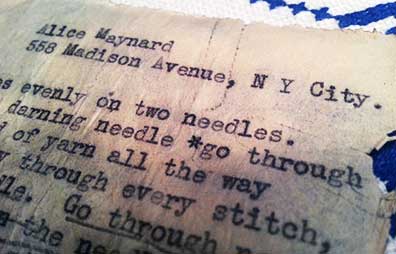
Alice Maynard
558 Madison Avenue, N Y City
I wondered who she was, what sort of apartment she would have had on Madison Avenue in the East Fifties, and why she was typing instructions for Kitchener stitch for one of my friend's relatives. The miracle of the Internet gave me an answer in seconds:
Expert Guidance Offered to Knitter and Crocheter (New York Times, August 18, 1964)
Knitting help at Macy's,* Gimbel's, and Bloomingdale's. The mind boggles.
If any of you have memories of knitting at Macy's, Gimbel's, or Bloomingdale's; or of shopping at Alice Maynard, I would love to hear about it in the comments.
*Although Macy's "has no time for anyone who has not mastered the basic stitches." Love it.
It's a sheet of the slick, translucent typing paper that some of us remember was called onionskin.
Yellowed, battered, and containing...

typed instructions for Kitchener stitch.
Below the typed copy is a spidery line of manuscript that reads...
ME spiral narrow at 19" narrow quickly
Somebody was making socks, I bet. Knee socks, maybe? If you were to knit a 19-inch tube, quick spiral decreases would give you a toe at the right point for a short woman's knee sock.
Or, possibly, "spiral" applies to "ME" and the socks were akin to the spiral stockings (knit without heel shaping) in Mary Thomas's Knitting Book.
I can't say with any certainty what "ME" means. Make Even? Possibly, though it's not a usage I have run across before.
In the upper right corner is a name and address:

Alice Maynard
558 Madison Avenue, N Y City
I wondered who she was, what sort of apartment she would have had on Madison Avenue in the East Fifties, and why she was typing instructions for Kitchener stitch for one of my friend's relatives. The miracle of the Internet gave me an answer in seconds:
Expert Guidance Offered to Knitter and Crocheter (New York Times, August 18, 1964)
Knitting help at Macy's,* Gimbel's, and Bloomingdale's. The mind boggles.
If any of you have memories of knitting at Macy's, Gimbel's, or Bloomingdale's; or of shopping at Alice Maynard, I would love to hear about it in the comments.
*Although Macy's "has no time for anyone who has not mastered the basic stitches." Love it.
Wednesday, May 28, 2014
Miniature Entry: Advice That Made a Difference
My favorite quote by the late Maya Angelou isn't from one of her poems, and in fact there's not even a trace of it (that I can find) online.
It came from an answer to a college student's question about changing the world. She told the student that if you want to change the world, start by making your bed every day.
Why?
Because if you haven't got sufficient will and dedication to do that one simple thing, you might want to reconsider whether you have what it takes to reach your more ambitious goals.
You don't have to agree with her about this. But I do. And it's one of the only pieces of Advice from a Sage Thinker that has made any damn difference in what I do with my day.
It came from an answer to a college student's question about changing the world. She told the student that if you want to change the world, start by making your bed every day.
Why?
Because if you haven't got sufficient will and dedication to do that one simple thing, you might want to reconsider whether you have what it takes to reach your more ambitious goals.
You don't have to agree with her about this. But I do. And it's one of the only pieces of Advice from a Sage Thinker that has made any damn difference in what I do with my day.
Thursday, April 17, 2014
Miniature Entry: On the Loss of a Great Writer
I wish I had something poetic to say about the wonderful Gabriel García Márquez, who has just died; but I don't.
Instead, I can tell you that in my freshman expository writing/fiction writing class at Harvard, which I hated, I once said in a discussion that I saw great similarities between the plots of "The Handsomest Drowned Man in the World" and Auntie Mame.
I did this just to provoke an aneurysm in a snooty bitch classmate from Miss Porter's. She always spoke in a breathy voice redolent of italics of her desire to "explode the confines of linear fiction," and she openly loathed me for turning in assignments that were funny. Every time one of my stories got a laugh, she would shake her Annie Hall bob in disgust and bite the end of her pen.*
It worked. She actually did get so angry she left the room. I've always been grateful to Mr. Márquez for that. And, of course, to Patrick Dennis.
This will probably be the only Márquez tribute that mentions them both.
RIP, Gabe.
Now I have to go finish roasting a chicken.
*She was also an avowed Freudian.
Instead, I can tell you that in my freshman expository writing/fiction writing class at Harvard, which I hated, I once said in a discussion that I saw great similarities between the plots of "The Handsomest Drowned Man in the World" and Auntie Mame.
I did this just to provoke an aneurysm in a snooty bitch classmate from Miss Porter's. She always spoke in a breathy voice redolent of italics of her desire to "explode the confines of linear fiction," and she openly loathed me for turning in assignments that were funny. Every time one of my stories got a laugh, she would shake her Annie Hall bob in disgust and bite the end of her pen.*
It worked. She actually did get so angry she left the room. I've always been grateful to Mr. Márquez for that. And, of course, to Patrick Dennis.
This will probably be the only Márquez tribute that mentions them both.
RIP, Gabe.
Now I have to go finish roasting a chicken.
*She was also an avowed Freudian.
Saturday, April 12, 2014
Miniature Entry: Life at Sea

At present I am aboard the Cunard liner Queen Victoria, sailing from San Francisco to Fort Lauderdale via the Panama Canal.
If you've been reading for a long time you know I love Cunard ships, past and present. I am supposed to be having (on doctor's orders) a complete rest from work but of course you know I wasn’t going to climb aboard without any knitting.
So I've taken to doing a little in the Winter Garden, in the mornings. As you would expect, it's a surefire conversation starter. The passengers are in the main fairly elderly. I wouldn't be surprised if a few of them knew Queen Victoria personally. When she was a little girl. I couldn't be happier–this is my crowd. We tend to like the same music and the same movies.
I was clicking away a few mornings ago as we headed for Costa Rica and a flurry of tropical print hove into view. The person in the print stopped, then dropped into the next chair. She was English, ambiguously eighty-ish, artfully preserved.
"That," she said, pointing at my knitting, "is very impressive work. My father was a knitter, so I know."
Whereupon we started chatting.
She is doing the World Cruise, Southampton to Southampton. This is something like her forty-fourth Cunard voyage. (The brand breeds loyalty.)
"Of course my favorite is and forever shall be the QE2," she said. "They'll never build another like her."
I nodded. I never sailed in her, mind you. I only saw her, once, back when I was on the Minerva II and she docked beside us in Malta. I remember that seeing C-U-N-A-R-D on the side of ship for the first time gave me chills.
"But may I say something? I'm going to say something."
She leant toward me and through her dark round sunglasses I could feel her glare. "You young* people," she said firmly, "have absolutely no stamina and no idea how to have a good time. No. Idea."
I raised my eyebrows.
She pointed towards the windows above us, which belong to Hemispheres–the ship's disco. "They will close that bar tonight at one o'clock and you will all go to sleep. Ridiculous. Ridiculous! On the QE2 we never dreamt of bed before sunrise. A party every night. Until sunrise. We knew how to have a good time. You young people, I don't know what's wrong with you."
"Well," I said, "the seventies were different, weren’t they? All that cocaine would keep anybody awake."
This time her eyebrows went up. She leant even closer.
"You'd better believe it, kid," she whispered. "You'd better believe it."
*Yes, on this ship I'm young. I'm quite possibly the youngest person aboard not scrubbing pots or being looked after by the Cunard nannies.
Note: The lady in the photograph is not the lady in the story. She's another lady, with whom I danced rather madly one evening.
Tuesday, March 18, 2014
Loretta
Monday, March 17, 2014
Miniature Entry: Other String
I'm in Madison, Wisconsin. This weekend was the local (enormous) guild's annual Knit-In, and they asked me to come up and do a bunch of fun stuff. On Friday I gave a talk. It was all very prim, as is my wont, but they made it sound dirty.
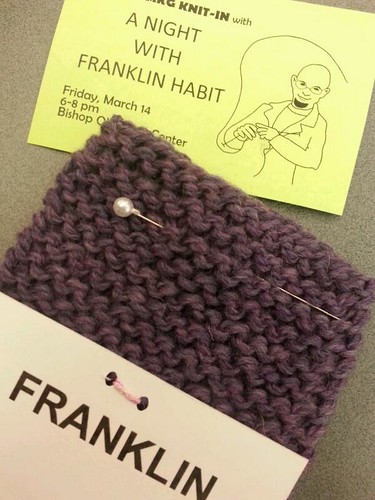
For the record, a night with me ends at about nine. Party down.
I leave for home in just a wee while but wanted to show a bit of progress with the tatting. When I remembered that dear, old Weldon's Practical Needlework had offered tatting numbers of course I had to pull them out and see if they were any good. Turns out they were.
Working in odd moments between furious, deadline-driven labor I've crept along to two-thread tatting (Some folks call it continuous tatting or tatting from the ball.) This is a Weldon's two-thread edging.
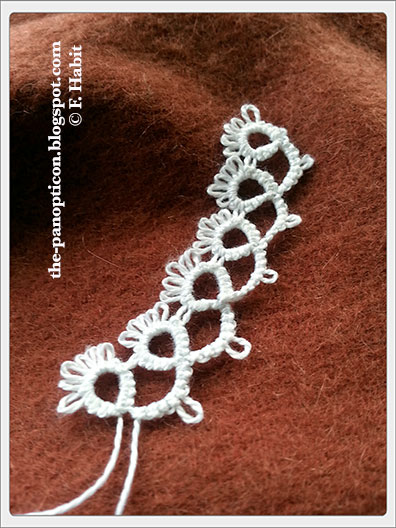
The thread (some old crochet cotton I had lying around) is really too coarse for the work and my tension is all over the place; but hey, I'm having a good time.
When I showed the first shots of my tatting I got a couple of comments–some quite concerned–that this must signal the end of my engagement with knitting. Really? Really? How? Why?
Are you afraid I'll be unable to resist the pull of the tatting market, and the legions of tatting enthusiasts who flock in their thousands to the glamorous international tatting circuit? Are you certain that within a year I'll have been put under contract to appear exclusively on one of the several tatting television series that ornament the airwaves?
This happens every time I mention a craft other than knitting.
So, to clarify.
If I write about a flirtation with crochet, tatting, weaving, embroidery, quilting, sewing, or any other fiber-y fabric-y gerund, it doesn't mean I'm jumping off the knitting ship. It means I'm looking to find out what else string can do for you. I find it refreshing. I find it inspiring. I don't believe in craft monogamy or textile purity. I'm all about seeing how techniques combine and complement.
I wrote a piece for Lion Brand Yarns about my desire to see knitting and crochet returned to their former unity. With John Mullarkey I've been mixing knitting and weaving in projects like our Ligeia Stole. And when a Madison student brought this in to show me, my heart skipped a beat:

She found it rolled up in her grandmother's sewing machine. On the right is a tatted chain. On the left is what the chain looks like when you complete the edging pattern with...crochet.
Mix it up. Mix. It. Up.

For the record, a night with me ends at about nine. Party down.
I leave for home in just a wee while but wanted to show a bit of progress with the tatting. When I remembered that dear, old Weldon's Practical Needlework had offered tatting numbers of course I had to pull them out and see if they were any good. Turns out they were.
Working in odd moments between furious, deadline-driven labor I've crept along to two-thread tatting (Some folks call it continuous tatting or tatting from the ball.) This is a Weldon's two-thread edging.

The thread (some old crochet cotton I had lying around) is really too coarse for the work and my tension is all over the place; but hey, I'm having a good time.
When I showed the first shots of my tatting I got a couple of comments–some quite concerned–that this must signal the end of my engagement with knitting. Really? Really? How? Why?
Are you afraid I'll be unable to resist the pull of the tatting market, and the legions of tatting enthusiasts who flock in their thousands to the glamorous international tatting circuit? Are you certain that within a year I'll have been put under contract to appear exclusively on one of the several tatting television series that ornament the airwaves?
This happens every time I mention a craft other than knitting.
So, to clarify.
If I write about a flirtation with crochet, tatting, weaving, embroidery, quilting, sewing, or any other fiber-y fabric-y gerund, it doesn't mean I'm jumping off the knitting ship. It means I'm looking to find out what else string can do for you. I find it refreshing. I find it inspiring. I don't believe in craft monogamy or textile purity. I'm all about seeing how techniques combine and complement.
I wrote a piece for Lion Brand Yarns about my desire to see knitting and crochet returned to their former unity. With John Mullarkey I've been mixing knitting and weaving in projects like our Ligeia Stole. And when a Madison student brought this in to show me, my heart skipped a beat:

She found it rolled up in her grandmother's sewing machine. On the right is a tatted chain. On the left is what the chain looks like when you complete the edging pattern with...crochet.
Mix it up. Mix. It. Up.
Friday, March 07, 2014
Tuesday, March 04, 2014
Miniature Entry: Intern
I decided that before one of this week's finished pieces goes to its forever home, it needs a little extra love. Pride in your finishing isn't everything, but it's almost everything.
I brought it with me here, to the coffee shop where I do so much work that we call it my field office. Between bouts of pattern writing I ripped out the imperfect seam and started sewing a new one.
A nice little girl, maybe six years old, came in with her mother for a hot chocolate. I liked her immediately, as you often do take to a person whose drink of choice is also yours.
As they sipped and chatted, it was pretty obvious the girl was curious about my work. The mother quietly told her to stop staring, but I asked if she'd like a closer look.
She stood at my shoulder and I showed her what I was doing with the needle. I chanted a little bit for her, the way I always do in my head when I sew by hand. Up, around, down, through. Up, around, down, through.
"Oh!" she said, after about six stitches. "I get it. You have to do it the same way, in the same places, all the way to the end. And that's how you win."
Kid, you're hired.

I brought it with me here, to the coffee shop where I do so much work that we call it my field office. Between bouts of pattern writing I ripped out the imperfect seam and started sewing a new one.
A nice little girl, maybe six years old, came in with her mother for a hot chocolate. I liked her immediately, as you often do take to a person whose drink of choice is also yours.
As they sipped and chatted, it was pretty obvious the girl was curious about my work. The mother quietly told her to stop staring, but I asked if she'd like a closer look.
She stood at my shoulder and I showed her what I was doing with the needle. I chanted a little bit for her, the way I always do in my head when I sew by hand. Up, around, down, through. Up, around, down, through.
"Oh!" she said, after about six stitches. "I get it. You have to do it the same way, in the same places, all the way to the end. And that's how you win."
Kid, you're hired.

Monday, March 03, 2014
Miniature Entry: On Pattern Writing
When you design knitting patterns for multiple clients, part of the deal is sending in your finished patterns using each client's house style.
This can become confusing when three patterns for three clients all reach the finish line simultaneously.
One client insists that "inches" always be written out in full; one insists you must always use the double apostrophe (non-curly!) and never the word; the third will only accept the abbreviation "in" (no period!).
You pause in your writing, and remember a very nice student asking, "Why don't we have one standard for knitting patterns? Don't you think that would be a good idea?" and you laugh quietly and reach for the rum bottle.
This can become confusing when three patterns for three clients all reach the finish line simultaneously.
One client insists that "inches" always be written out in full; one insists you must always use the double apostrophe (non-curly!) and never the word; the third will only accept the abbreviation "in" (no period!).
You pause in your writing, and remember a very nice student asking, "Why don't we have one standard for knitting patterns? Don't you think that would be a good idea?" and you laugh quietly and reach for the rum bottle.
Wednesday, February 26, 2014
New Tat
This month I was out in Tacoma, Washington for one of the grooviest fiber gatherings you'll ever encounter–the Madrona Fiber Arts Winter Retreat. I was enjoying a rare morning off when I found a bunch of tatting shuttles for sale at the Carolina Homespun booth in the marketplace.
Tatting shuttles are used for making tatted lace. Tatted lace is very pretty. I did not know how to make tatted lace. All I knew about making tatted lace is that many, many of my friends have tried to make it, and have failed spectacularly.
So I bought two shuttles (silver, brass). I also bought cotton thread to go with the shuttles (white, ecru). I very nearly bought a third shuttle (bone); but buying three would have been silly.
That morning was my only free time for the whole of the festival, so it wasn't until I headed home that I got a chance to unwrap the shuttles and fiddle with them. My first flight out of Seattle was canceled, so I spent five hours in the Alaska Airlines Board Room drinking fruit juice and watching "Tatting for Beginners" videos on YouTube.
This is where I began.

This is where I ended, five hours later.

To give you an idea of how small that loop is, if I inhale deeply it will disappear right up my nose.
Perhaps you are entirely unfamiliar with tatting and would like to know how it works. Here is a brief overview.
Tatted lace is really just a series of simple knots tied one after the other into a piece of string. You begin by winding the string onto shuttle, as shown above.
Then you pull a little string off the shuttle and wrap a loop of it around your left hand. Then it's sort of like your left hand is doing cat's cradle, and your right hand is tying sailor knots, and meanwhile you are having a sneezing fit.
Tatting is something that gets mentioned all the time in those 19th century books I read. Usually it's the daily occupation of a frustrated maiden aunt with dim eyesight. She sits in her room all day, embalmed in black bombazine, morosely tossing the shuttle from hand to hand. You think knitting has a reputation for being stuffy? Honey, compared to tatting, knitting is a drug-happy orgy being thrown by a Playboy bunny in the zero-gravity Jacuzzi of a rocket ship headed for Jupiter. Tatting is for people who are afraid to try lace knitting because they think it will make them look slutty.
Needless to say, I find the appeal irresistible.
Back at home, as a break from the deadlines that are the reason this is the only post for February, kept at it. At great length, I made a ring almost (but not quite) the size of half a dime.
Then for about a week I just kept making rings, which are formed by a series of double stitches. Part of the fun of tatting is that the very first thing you learn, the thing you must learn before you can do anything else, is the double stitch. But the double stitch is, so far as I can tell, the hardest thing to do in all of tatting. So once you scale that wall, you're in good shape. But it's a very tall wall, crumbly, without a lot of good footholds; and there are gargoyles at the top who keep pooping on you.
Anyway, to practice my double stitches I just kept making them, and turning them into rings.

They're not difficult, really; but you have to do them all perfectly or your chain will freeze and won't close into a ring. If you mess up even one, the only thing you can do is get a pin and a magnifying glass and unpick all the way back to that stitch, one knot at a time, and do it over.
I will never complain about ripping back my knitting ever again.
Once I had something of a grip on rings I moved on to picots, which look like little mouse ears.

Here's my current chef d'oeuvre: two rings of the same size with picots that are pretty much the same size if you step well back and squint.
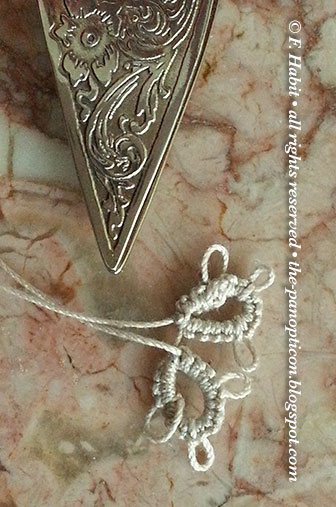
I don't need to learn tatting, you know. It's not like my life lacks for diversion. But I spend a great deal of each day knitting, and sometimes I find it fascinating to see what else string can do for you.
P.S. Before you mention it, I already know that there is such a thing as needle tatting and needle tatting has a reputation for being faster to learn. However, needle tatting does not give you an excuse to buy pretty shuttles. Nor am I much interested in going faster. Slow and painstaking suits me fine, thanks.
On the Horizon
On the calendar, may I please draw your attention to a few noteworthy additions you may find interesting?
March 29-30, I'll be at a shop I've been hoping to visit for years–the inimitable A Verb for Keeping Warm in Oakland, California. There will be both classes and the lecture I think I may need to re-title "The One with the Victorian Bathing Drawers."
April 25ish-26ish, I'll be at dear, old Yarn Over in Minneapolis, and also doing some classes (to be announced) at StevenBe. At the Yarn Over dinner, I'll be debuting my new talk for this year, "Five Women, Five Shawls." There will be history, as ever–but this time most of the history will be personal.
And May 3-6, one of the things I'm looking forward to most this year: the North Light Fibers Retreat on Block Island. A quiet, beautiful island off the coast of Rhode Island, in May, headquartered in a couple of handsome Victorian hotels? Plus knitting? And run by a small luxury fiber company? Do you see why I said yes? Four seconds after they asked?
My life is rough. Come share it.
Tatting shuttles are used for making tatted lace. Tatted lace is very pretty. I did not know how to make tatted lace. All I knew about making tatted lace is that many, many of my friends have tried to make it, and have failed spectacularly.
So I bought two shuttles (silver, brass). I also bought cotton thread to go with the shuttles (white, ecru). I very nearly bought a third shuttle (bone); but buying three would have been silly.
That morning was my only free time for the whole of the festival, so it wasn't until I headed home that I got a chance to unwrap the shuttles and fiddle with them. My first flight out of Seattle was canceled, so I spent five hours in the Alaska Airlines Board Room drinking fruit juice and watching "Tatting for Beginners" videos on YouTube.
This is where I began.

This is where I ended, five hours later.

To give you an idea of how small that loop is, if I inhale deeply it will disappear right up my nose.
Perhaps you are entirely unfamiliar with tatting and would like to know how it works. Here is a brief overview.
Tatted lace is really just a series of simple knots tied one after the other into a piece of string. You begin by winding the string onto shuttle, as shown above.
Then you pull a little string off the shuttle and wrap a loop of it around your left hand. Then it's sort of like your left hand is doing cat's cradle, and your right hand is tying sailor knots, and meanwhile you are having a sneezing fit.
Tatting is something that gets mentioned all the time in those 19th century books I read. Usually it's the daily occupation of a frustrated maiden aunt with dim eyesight. She sits in her room all day, embalmed in black bombazine, morosely tossing the shuttle from hand to hand. You think knitting has a reputation for being stuffy? Honey, compared to tatting, knitting is a drug-happy orgy being thrown by a Playboy bunny in the zero-gravity Jacuzzi of a rocket ship headed for Jupiter. Tatting is for people who are afraid to try lace knitting because they think it will make them look slutty.
Needless to say, I find the appeal irresistible.
Back at home, as a break from the deadlines that are the reason this is the only post for February, kept at it. At great length, I made a ring almost (but not quite) the size of half a dime.
Then for about a week I just kept making rings, which are formed by a series of double stitches. Part of the fun of tatting is that the very first thing you learn, the thing you must learn before you can do anything else, is the double stitch. But the double stitch is, so far as I can tell, the hardest thing to do in all of tatting. So once you scale that wall, you're in good shape. But it's a very tall wall, crumbly, without a lot of good footholds; and there are gargoyles at the top who keep pooping on you.
Anyway, to practice my double stitches I just kept making them, and turning them into rings.

They're not difficult, really; but you have to do them all perfectly or your chain will freeze and won't close into a ring. If you mess up even one, the only thing you can do is get a pin and a magnifying glass and unpick all the way back to that stitch, one knot at a time, and do it over.
I will never complain about ripping back my knitting ever again.
Once I had something of a grip on rings I moved on to picots, which look like little mouse ears.

Here's my current chef d'oeuvre: two rings of the same size with picots that are pretty much the same size if you step well back and squint.

I don't need to learn tatting, you know. It's not like my life lacks for diversion. But I spend a great deal of each day knitting, and sometimes I find it fascinating to see what else string can do for you.
P.S. Before you mention it, I already know that there is such a thing as needle tatting and needle tatting has a reputation for being faster to learn. However, needle tatting does not give you an excuse to buy pretty shuttles. Nor am I much interested in going faster. Slow and painstaking suits me fine, thanks.
On the Horizon
On the calendar, may I please draw your attention to a few noteworthy additions you may find interesting?
March 29-30, I'll be at a shop I've been hoping to visit for years–the inimitable A Verb for Keeping Warm in Oakland, California. There will be both classes and the lecture I think I may need to re-title "The One with the Victorian Bathing Drawers."
April 25ish-26ish, I'll be at dear, old Yarn Over in Minneapolis, and also doing some classes (to be announced) at StevenBe. At the Yarn Over dinner, I'll be debuting my new talk for this year, "Five Women, Five Shawls." There will be history, as ever–but this time most of the history will be personal.
And May 3-6, one of the things I'm looking forward to most this year: the North Light Fibers Retreat on Block Island. A quiet, beautiful island off the coast of Rhode Island, in May, headquartered in a couple of handsome Victorian hotels? Plus knitting? And run by a small luxury fiber company? Do you see why I said yes? Four seconds after they asked?
My life is rough. Come share it.
Saturday, January 18, 2014
Miniature Entry: New York
The desk clerk on the second floor at The Strand looked exactly like a Fred Armisen character from Portlandia and I was going to snicker and then I realized that I was wearing a bow tie and a 1930s Swedish shooting jacket and a newsboy cap and wingtip shoes and a chin beard and so do I.


Friday, January 10, 2014
YO, Mama
There is no other way to start than with a word of thanks. Your reaction to the bathing drawers was everything I could have wished. Quite aside from the compliments, for which I am grateful, I was so happy (and relieved) that my preamble was taken as it was intended: as a plea for civility, not for praise.
You might like to know that the drawers will be going on the road. I'm heading to St Louis and the Kirkwood Knittery, and on the evening of January 24 I'll be giving one of my favorite talks: Impractical Magic: Oddities and Curiosities from Weldon's Practical Needlework. (Seating is limited. For tickets, call the shop.) The original photogravure from the pattern has been the title card for that lecture since I wrote it, and now I'm thrilled to present a realized specimen.
Around the same time I finished those, I finished a simple design that has since come out as part of a collaborative eBook, Dreaming of Shetland. The project was undertaken in support of Deborah Robson's research into Shetland sheep and Shetland wools, about both of which I am unabashedly crazy. Deb and I had a chat about it a year ago at the Madrona Fiber Arts Winter Retreat (read her own words here), so when the chance came to help support her I jumped at it.
This was my contribution: a lace scarf called "Fair Phyllida."
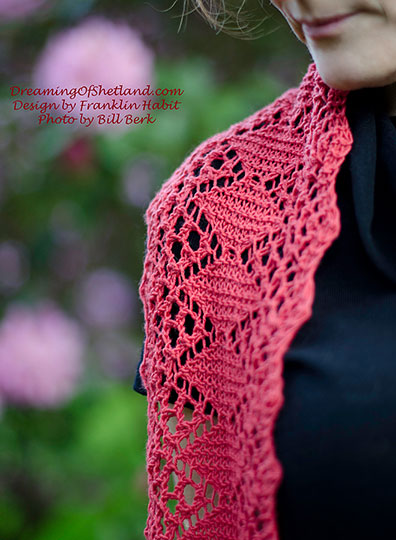
You may be aware that I have borderline-creepy obsession with old lace edgings. My first sketch for this piece was, rather unsurprisingly, a scarf with a lace edging.
Then I thought–why fool around with the scarf part? Why not make the whole thing an edging? So I fixated on a 19th-century Shetland motif as my point of departure, fussed with it, mirrored it, and this was the result.

Fair Phyllida is a gentle ride. (That doesn't sound quite right, does it? Never mind, time presses. Moving on.) If you have basic lace-knitting skills, you can do her. (No. Never mind, moving on.)
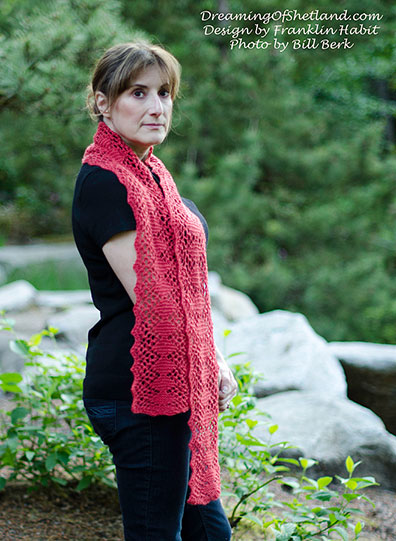
There are all kinds of things (not all of them lacy) designed by all kinds of people in the book, from bags and mitts to wristlets, shawls, and baby clothes. Take a look.
So's Your Mother
A couple of months ago, in my monthly column for Lion Brand Yarns I presented a selection of riddles reimagined for the yarn-centric. A friend who read it asked me if I'd consider doing the same for her favorite humorous tradition: the yo mama (var. yo momma, yer mom, yer mum, tu mamà) joke.
Before you curl your lip, please remember that maternal insults, like motherhood, have probably always been with us. They are ancient. They are hallowed. They go back as least as far as Shakespeare, who used them; they are almost certainly far older than that. My knowledge of classical theater is imperfect, but if there's not a yo mama joke in Oedipus Rex, there should be.
That being said, if you're one of the gentle, dewy-eyed souls who is never remotely amused by this sort of thing, you'll want to stop scrolling now and head elsewhere.
I mean it.
Seriously, stop now.
Okay, fine.
I warned you.
Yo mama's so skinny, she tripped and fell through a yarn over.
Yo mama's so tall, when she drops a stitch it takes three weeks to hit the ground.
...
Finis
You might like to know that the drawers will be going on the road. I'm heading to St Louis and the Kirkwood Knittery, and on the evening of January 24 I'll be giving one of my favorite talks: Impractical Magic: Oddities and Curiosities from Weldon's Practical Needlework. (Seating is limited. For tickets, call the shop.) The original photogravure from the pattern has been the title card for that lecture since I wrote it, and now I'm thrilled to present a realized specimen.
Around the same time I finished those, I finished a simple design that has since come out as part of a collaborative eBook, Dreaming of Shetland. The project was undertaken in support of Deborah Robson's research into Shetland sheep and Shetland wools, about both of which I am unabashedly crazy. Deb and I had a chat about it a year ago at the Madrona Fiber Arts Winter Retreat (read her own words here), so when the chance came to help support her I jumped at it.
This was my contribution: a lace scarf called "Fair Phyllida."

You may be aware that I have borderline-creepy obsession with old lace edgings. My first sketch for this piece was, rather unsurprisingly, a scarf with a lace edging.
Then I thought–why fool around with the scarf part? Why not make the whole thing an edging? So I fixated on a 19th-century Shetland motif as my point of departure, fussed with it, mirrored it, and this was the result.

Fair Phyllida is a gentle ride. (That doesn't sound quite right, does it? Never mind, time presses. Moving on.) If you have basic lace-knitting skills, you can do her. (No. Never mind, moving on.)

There are all kinds of things (not all of them lacy) designed by all kinds of people in the book, from bags and mitts to wristlets, shawls, and baby clothes. Take a look.
So's Your Mother
A couple of months ago, in my monthly column for Lion Brand Yarns I presented a selection of riddles reimagined for the yarn-centric. A friend who read it asked me if I'd consider doing the same for her favorite humorous tradition: the yo mama (var. yo momma, yer mom, yer mum, tu mamà) joke.
Before you curl your lip, please remember that maternal insults, like motherhood, have probably always been with us. They are ancient. They are hallowed. They go back as least as far as Shakespeare, who used them; they are almost certainly far older than that. My knowledge of classical theater is imperfect, but if there's not a yo mama joke in Oedipus Rex, there should be.
That being said, if you're one of the gentle, dewy-eyed souls who is never remotely amused by this sort of thing, you'll want to stop scrolling now and head elsewhere.
I mean it.
Seriously, stop now.
Okay, fine.
I warned you.
Yo mama's so short, she needs a ladder to read the top row
of a chart.
...
Yo mama's so old, she remembers when they invented the
second knitting needle.
...
Yo mama's so skinny, she tripped and fell through a yarn over.
...
Yo mama's so stupid, she thinks stranded colorwork is stuck
at the airport.
...
Yo mama's so lazy, she gets First Sock Syndrome.
...
Yo mama's so tall, when she drops a stitch it takes three weeks to hit the ground.
...
Yo mama's so cheap, she tries to k2tog with one stitch.
...
Yo mama's so fat, she can't even cross her cables.
...
Yo mama's so ugly, she can only get gauge by sneaking up on
it.
...
Yo mama's so fat, she tried to make an Elizabeth Zimmermann
percentage sweater and ran out of numbers.
...
Yo mama's so fat, she tried to make an Elizabeth Zimmermann
percentage sweater and ran out of numbers.
...
Yo mama's so greasy, all
her stitches are slipped stitches.
...
Yo mama's so stupid, when she saw "k1 tbl" she
knit a coffee table.
...
Yo mama's so chunky, she knits up at three stitches to the
inch.
...
Yo mama's so hairy, she is easily mistaken for a ball of
Rowan Kidsilk Haze.
...
Yo mama's so twisted, she biases sharply to the left when
worked in stockinette.
...
Finis

